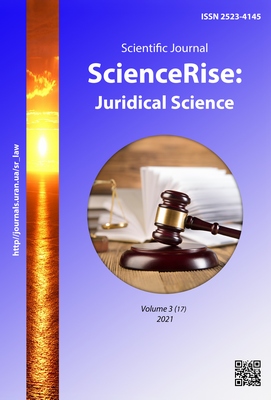Features of the use of legal terminology in the countries of the European Union
DOI:
https://doi.org/10.15587/2523-4153.2021.241513Keywords:
term, legal terminology, law, language of law, normative legal act, European Union, formal certainty, legislation, legal systemAbstract
The article examines the issue of the peculiarities of the use of legal terminology in the countries of the European Union. It is emphasized, that the reform of domestic legislation and its approximation to world standards requires thorough research of European legislation. In particular, the cornerstone of today's challenge is the proper use and common approaches to the use of legal terminology. That is why theoretical research on the peculiarities of the use of legal terminology in the legislation of the European Union is necessary to properly improve domestic legislation and avoid mistakes and misunderstandings in the future.
Emphasis is placed on the fact that domestic and foreign researchers have not developed a unified approach to understanding the term "terminology". That is why this term is used in three different meanings. It is also noted, that the category "term" is not new and has been in the field of view of researchers for a long time, but its direct study has only recently begun.
It is noted, that legal terminology is considered as technical, i.e.it is the most noticeable and striking linguistic feature of legal language. In this sense, legal terminology is used to denote concepts that belong to the legal field.
It is emphasized that, in contrast to the systemic languages, used in national texts, the European Union resorts to a form of "cultural communication", governed by multilingualism. Such communication is considered cultural because it is not rooted in any of the national cultures of the EU Member States. Legal acts, adopted by the EU institutions, which are to be applied and enforced in all Member States, must avoid cultural specificities and, therefore, the concepts or terminology specific to any one national legal system must be used with caution
References
- Uhoda pro asotsiatsiiu mizh Ukrainoiu, z odniiei storony, ta Yevropeiskym Soiuzom, Yevropeiskym spivtovarystvom z atomnoi enerhii i yikhnimy derzhavamy-chlenamy, z inshoi storony (2014). Uhoda, Spysok, Mizhnarodnyi dokument No. 984_011. 27.06.2014. Available at: https://zakon.rada.gov.ua/laws/show/984_011#Text
- Peruzzo, K. (2011/2012). Terminological Equivalence and Variation in the EU Multi-level Jurisdiction: A Case Study on Victims of Crime. ANNO ACCADEMICO, 316. Available at: https://www.academia.edu/3845078/Terminological_Equivalence_and_Variation_in_the_EU_Multi_level_Jurisdiction_A_Case_Study_on_Victims_of_Crime?email_work_card=view-paper
- Stanisław, G.-R., Iwona, W.-P. (2011). Editorial to Special Issue on Legal Terminology. Research in Language, 9 (1), 5–8. doi: http://doi.org/10.2478/v10015-011-0015-z
- Jopek-Bosiacka, A. (2011). Defining Law Terms: A Cross-Cultural Perspective. Research in Language, 9 (1), 9–29. doi: http://doi.org/10.2478/v10015-011-0008-y
- Bajcic, M. (2011). Conceptualization of Legal Terms in Different Fields of Law: The Need for a Transparent Terminological Approach. Research in Language, 9 (1), 81–93. doi: http://doi.org/10.2478/v10015-011-0001-5
- Chiocchetti, E., Ralli, N. (2011). Legal Terminology and Lesser Used Languages: The Case of Mòcheno. Research in Language, 9 (1), 135–146. doi: http://doi.org/10.2478/v10015-011-0003-3
- Robertson, C. (2011). Multilingual Legislation in the European Union. EU and National Legislative-Language Styles and Terminology. Research in Language, 9 (1), 51–67. doi: http://doi.org/10.2478/v10015-011-0011-3
- Cabré, M. T. (1999) Terminology: Theory, Methods and Applications. Amsterdam/Philadelphia: John Benjamins, 248. doi: http://doi.org/10.1075/tlrp.1
- Magris, M.; Prado, D. (Ed.) (2002). La banca dati terminologica TERMITdella S.S.L.M.I.T. dell’Università di Trieste. La terminologia in Italia. Unione Latina, 48–57.
- Myking, J.; Antia, E. (Ed.) (2007). No Fixed Boundaries. Terminology and LSP: Studies in Honour of Heribert Picht, B. Amsterdam/Philadelphia: John Benjamins, 73–91. doi: http://doi.org/10.1075/tlrp.8.10myk
- Kageura, K. (2002). The Dynamics of Terminology: A Descriptive Theory of Term Formation and Terminological Growth. Amsterdam/Philadelphia: John Benjamins. doi: http://doi.org/10.1075/tlrp.5
- Gotti, M.; Kredens, K., Goźdź-Roszkowski, S. (Eds.) (2007). Legal Discourse in Multilingual and Multicultural Contexts. Language and the Law: International Outlooks. Frankfurt am Main: Peter Lang, 21–33.
- Fomina, I. N. (2019). Eurospeak and the Russian terminology of law: translation challenges. Professional Discourse & Communication, 1 (3), 41–49. doi: http://doi.org/10.24833/2687-0126-2019-1-3-41-49
- Kjær, A. L.; Kredens, K., Goźdź-Roszkowski, S. (Eds.) (2007) Legal Translation in the EuropeanUnion: A Research Field in Need of a New Approach. Language and the Law: International Outlooks. Frankfurt am Main: Peter Lang, 69–95.
Downloads
Published
How to Cite
Issue
Section
License
Copyright (c) 2021 Viktor Lazariev

This work is licensed under a Creative Commons Attribution 4.0 International License.
Our journal abides by the Creative Commons CC BY copyright rights and permissions for open access journals.
Authors, who are published in this journal, agree to the following conditions:
1. The authors reserve the right to authorship of the work and pass the first publication right of this work to the journal under the terms of a Creative Commons CC BY, which allows others to freely distribute the published research with the obligatory reference to the authors of the original work and the first publication of the work in this journal.
2. The authors have the right to conclude separate supplement agreements that relate to non-exclusive work distribution in the form in which it has been published by the journal (for example, to upload the work to the online storage of the journal or publish it as part of a monograph), provided that the reference to the first publication of the work in this journal is included.









